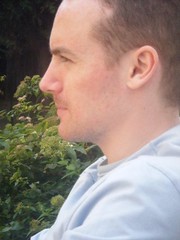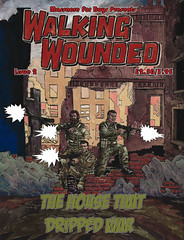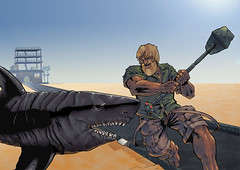Alex Finch interviews Massacre For Boys artist Steven Denton
As one of the founders of Massacre For Boys, can you tell us about the initial idea for setting it up?
It was an accident… Well maybe accident is not entirely fair, it developed out of a desire for people to actually read our comics. As far back as the early 90’s we had experimented with self publishing in a small way but never really managed to find a plausible method of advertising and distribution so that all stalled fairly quickly. For a little while a lot later in the 90s we discovered the mail order zines community and I became a regular contributor as an illustrator on some fantasy and horror publications, that was my first experience of the small press but we still neither had the equipment or the desire to really publish our own magazine.
I completed a politically charged comic called ‘Another World’ just after university and put it together 90’s bedroom zine style. Photocopied glued and stitched by hand and looking pretty shabby even if I do say so myself. I made exactly 6 copies and gave a few to friends, all in all not a gigantic commercial success but it did kick start our current interest in self publishing.
Chris did all the real legwork, the original Walking Wounded story ‘the resistance that went mad’ was our only complete publishable comic, dating back as far as 1994. A new cover some new pages and some fairly shabby new hand lettering and he was ready to go to print. Chris proved that we could not only print our own comic but if we got off our arses we could even sell it to people we have never met before simply by taking it to comic shows.
Massacre For Boys was born out of a shared love for the British comics of the 1970’s and 80’s. As an umbrella theme Massacre For Boys allows us to explore any thing from football strips too Marvel UK style superheroes and the desire to sell our comics at shows keeps our jokes from becoming too esoteric.
What are your feelings about how the comic has changed and developed as more characters / genres have been introduced?
I have always liked the anthology format and by its nature it is best suited to a fairly wide spread of characters and it gave us a pretty free rein over the type of story that we want to work on. Anthologies need a core theme to hold them together, the way 2000AD had sci-fi and Battle was full of war stories, the Eagle re-launch and Hotspur were more anything that could be classed as a boys own adventure under one roof. With so many influences and stories to tell it never was going to be easy to put out just one comic, all the other ideas, some connected some not, would constantly be scrabbling to get out. A lot of the characters we are working on for our comics have been with us for a very long time so for us I think it seems less like introducing new characters and more like including more of our long term ideas.
What is that attracts you to the comics industry over more traditional forms of art?
I have an early childhood memory of the Eagle re-launch way back in 1982 being read to me as I looked memorized at the artwork. I think it was love at first sight. One summer holiday I picked up both the eagle and 2000AD at our local news agents (the renewed R.G. Styles and sons, a news agent of the old school who would remember your name) and I then collected one or the other continuously for the next 25 years. The Comics industry is in a sorry state and as an artist it’s insane to pursue it as a career path. Comics are a unique medium and it’s more the visual and written story telling combined that attracts me. If it wasn’t comics it would be picture books of short films. I find the combination narrative mediums seductive. I flirted with film making and animation but it takes a committed team to produce a short film, it only takes one committed hand to create a comic.
What's the most difficult subject you've had to draw so far? And how did you go about tackling this?
For me it’s all hard. I’ve put a lot of work recently into measured perspective and technical drawing. I have never really found drawing easy and I find the technical aspects a particular challenge. Within any comic there are always going to be individual challenges like drawing complex objects or backgrounds and I normally cope with that by good research and reference. I can’t emphasis enough how much a real world starting point has helped me in the consistency of my art work.
Out of all your work so far, what are you most proud of?
Issue 2 of Walking Wounded stands out in places for me. It’s not perfect but it has a visual coherency and solidity that I think makes it rank as my finest comic work to date. I’m particularly proud of the way that The Glasshouse turned out.
Who would you say your main influences are?
I tried to make a list of main influences but gave up after putting down about 50 names and realizing I was nowhere near done. When I was younger I was heavily influenced by Carlos Esquerra, Colin MacNeil and Chris Weston amongst many many others but I think you can still see their stamp on my artwork.
As well as your work as an artist, you've also taken on scripting duties from time to time - is this something you wish to pursue in the future?
One of the things I have been extremely fortunate with in the small press is the opportunity it has given me to collaborate with a number of different writers and artists. Although I said earlier that comics could be produced by a one man band I enjoy the creative dynamic of collaboration and have contributed as an artist writer and colourists for other peoples line work. Time permitting I hope to continue and refine all of my skills. The idea is the easy part with a story, it’s the seed, whether it’s as a collaboration or as a solo author the real craft is learning how to make it grow either by yourself or with the help of others.
How do you feel about the small press industry? And if more mainstream publishers come calling, would you still wish to be involved in it?
The small press is a pretty social scene. Most the customers are creators themselves and every one seems pretty passionate about art in some form. A lot of people look at comics and books and films and think ‘I could do that’ the small press it full of people who thought that and then did it. You have to respect that. Sure if a main stream publisher started banging on the door we would be crazy not to give the big time a shot but once you have been in the small press you would have to be some kind of jerk to move on up and not support it any more.
What can you tell us about your work outside of Massacre For Boys?
Largely I contribute to a few Futurequake Press titles as both a writer and artist working on Futurequake, Something Wicked, Zarjaz and Dogbreath. I have coloured pages for P J Holden and Dave Evans and coloured 2 Paragon covers for Dave Candlish. So I’ve put my work about as a bit of a small press Mick Jagger.
If you could draw any existing comics' character, who would it be and why?
Judge Dredd, written by John Wagner. Because no other character holds the same place in my heart or my personal history.
Finally, what can we expect from you in the future?
Mad Max style global apocalypses, gangs of leather clad sci-fi petrol punks roaming the scorched desert prating on the small communities that are all that’s left of humanity, clinging desperately to life on our once green planet. But moving to comics, more Walking Wounded, more Futurequake, more colouring. More comics, basically. Oh, and a Holt Bros graphic novel.
Alex Finch is still a writer, researcher, actor, stage manager and former celebrity Text Jockey.
Subscribe to:
Post Comments (Atom)






No comments:
Post a Comment